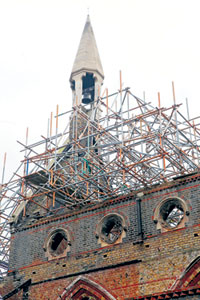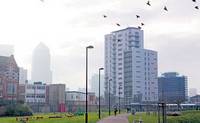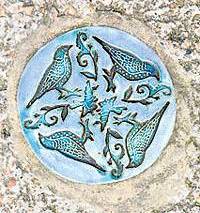Warm yourself with a winter stroll around E14
By Graham Barker
20 December 2010
Download a map for this walk
At this time of year, a brisk walk can be a great way to warm up. So put on your winter woollies and stride out on this route around Poplar – and before long you’ll be feeling toasty.
Along the way, you’ll discover a lively mix of market stalls and shops, wander by parks and waterways, and encounter local history and street sculptures.
We start this month’s walk at Langdon Park DLR station (1). Before you head off, take a look at the large silver ‘Whooosh’ sculpture and the whirl of silver pavement discs beside the station. Langdon Park School stands ahead of you, topped by a pair of green copper domes. It specialises as a sports college, and as you continue along Hay Currie Street you’ll pass by its running track and sports pitches.
a look at the large silver ‘Whooosh’ sculpture and the whirl of silver pavement discs beside the station. Langdon Park School stands ahead of you, topped by a pair of green copper domes. It specialises as a sports college, and as you continue along Hay Currie Street you’ll pass by its running track and sports pitches.
After the car park, turn right on Willis Street over the blue DLR bridge and veer left towards Chrisp Street Market (2). Marked out by its glazed canopy and distinctive diamond-patterned clock tower, the market precinct was designed by Frederick Gibberd as part of the ‘living architecture’ element of the 1951 Festival of Britain. As  the first purpose-built pedestrian shopping centre in the UK, it became a landmark in new urban design, and next year celebrates its 60th anniversary.
the first purpose-built pedestrian shopping centre in the UK, it became a landmark in new urban design, and next year celebrates its 60th anniversary.
The market is still lively, with stalls selling clothes, household wares, fruit and vegetables. At this time of year, you might want to snap up some Christmas goodies too. The area around here – including the Victorian Chrisp Street market – suffered badly from World War II bombing. The council decided to redevelop the area as the Lansbury Estate, named after the popular local councillor and Labour leader, George Lansbury. Over the ensuing 30 years or so, the estate evolved, stretching as far west as Piggott Street.
On the southern side of the covered market, make a detour along Vesey Path, flanked by butchers, bakers and... who knows, maybe there’s a candlestick maker here somewhere. The run of green and blue glass beside you is the Chrisp Street Idea Store (3), which sits prominently overlooking East India Dock Road. Pause too, whilst you’re here, to peer across the road towards art deco-styled Poplar Baths (4). Currently derelict but still eerily beautiful, this is “a stunning building with a Hollywood style interior and beautiful vaulted ceiling” according to architect Piers Gough.
A bronze statue of local shipbuilder and philanthropist Richard Green sits in front, with his dog beside him. And to your left, the ornate white spire of All Saints Church is visible beyond the trees.
Retrace your steps back to the main market precinct and continue diagonally left through the square and along Market Way. Here you’ll find even more shops, including a tasty sweet centre, vibrant sari shops and the local Sure Start. After the archway, cut through the tree-dotted square, cross Cordelia Street and snake your way through the large open green beyond (5), keeping on the central path as it heads slightly to the left, past metal benches.
In Ellesmere Street, opposite the shops, take a spin around the small green laid out with a brickwork spiral, before continuing down the walkway alongside. As you face  the Brabazon Street sports court and green, turn left to Bartlett Park (6), taking care when you cross Upper North Street.
the Brabazon Street sports court and green, turn left to Bartlett Park (6), taking care when you cross Upper North Street.
The park was named after the much-liked Rev Philip Bartlett and as you approach along Arcadia Street you’ll spot what remains of his church, St Saviour’s – the gabled walls and gutted remains now stand forlorn, supported by a spiky scaffolding skeleton. Just before the crescent of houses starts, enter the park entrance and follow the path  to the far side. Beyond the football pitches there are open views across to Canary Wharf. Then leave the park via an alleyway on to Cotall Street, with a red pillar-box standing as sentry.
to the far side. Beyond the football pitches there are open views across to Canary Wharf. Then leave the park via an alleyway on to Cotall Street, with a red pillar-box standing as sentry.
Follow the green railings to the right and slope down through the metal arched entrance to join the canalside. You now have a stretch of waterside walking, following the Limehouse Cut as it runs straight as an arrow towards Three Mills and the River Lea, surrounded by new building developments.
En route, look out for the long, mosaic panel (7). It depicts lots of local sights situated between Limehouse Basin and Three Mills – see how many of them you recognise. Among them, you might spot a dog biscuit. But this is not any old dog biscuit, this is a Spratt’s dog biscuit, which would have been made in the imposing brick building a short way along the towpath.
Now converted to warehouse apartments, the former factory of Spratt’s Patent Limited (8) still bears the sign-written Spratt’s name on the gable walls. You can wander up the steps on to the Violet Road bridge to take a closer look.
The innovative American businessman James Spratt launched the world’s first dog  biscuits around 1860, known as “meat fibrine dog cake”, a mix of wheat meal, vegetables, beetroot and meat. One of his first employees was Charles Cruft, still remembered for the dog shows he later established.
biscuits around 1860, known as “meat fibrine dog cake”, a mix of wheat meal, vegetables, beetroot and meat. One of his first employees was Charles Cruft, still remembered for the dog shows he later established.
Rejoin the towpath and continue under the blue DLR bridge. Leave the canal up the next slope to emerge beside a small landscaped green. Follow the paved walkway ahead on Celtic Street and then arch over the next shallow grassy mound. Your path is studded with decorative ceramic plaques, beautifully designed with birds, plants and  other natural images.
other natural images.
The building beside you is the Teviot Centre (9), one of several community centres managed by housing association Poplar Harca. Here you can drop in for refreshments at the café, or participate in language classes, health workshops or children’s activities. Opposite is Manorfield Primary School, bright and bold in red, blue and ochre.
Follow St Leonard’s Road to your left and Langdon Park soon opens out on the other side of the road, marked by the eye-catching white lettering above the DLR station. But before you cross, you might want to take a closer look at the former St Michael’s and All Angels Church (10) on your left, with its decorative brickwork, soaring clock tower and, just beyond, a beautiful war memorial. And finally, head through Langdon Park, back to the DLR station, the end of this walk.
Download a map for this walk